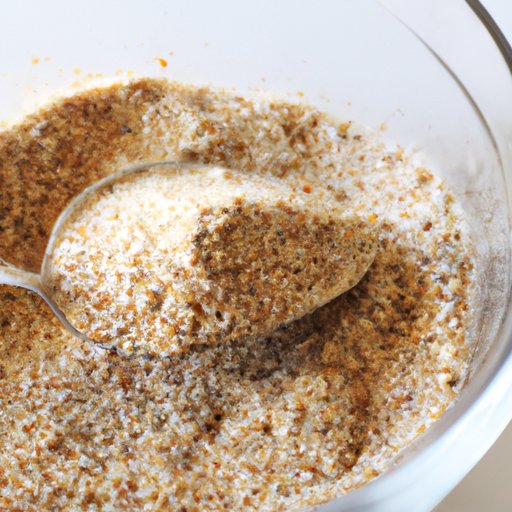Introduction
Have you ever started a recipe only to realize that you’re out of bread crumbs? Or maybe you’re just looking for a way to use up some leftover bread? Whatever the reason, making bread crumbs from scratch is easier than you might think. In this article, we’ll provide you with a step-by-step guide, tips on how to get the best results, and creative ideas for using breadcrumbs in your cooking.
Step-by-Step Guide
To make bread crumbs, you’ll need a few simple tools: a food processor or blender, a baking sheet, and some bread. The type of bread you use is up to you, although some types (such as sourdough) may require some extra seasoning to add flavor. You can use fresh, sliced bread, day-old bread, or even stale bread.
If you’re using fresh bread, you’ll need to dry it out before blending it into crumbs. You can do this by toasting the bread in a low oven (about 250°F) until it’s dry and crisp, or by leaving it out on the counter for a day or two until it’s stale.
Once your bread is ready, it’s time to turn it into crumbs. First, tear or cut the bread into small pieces and add it to your food processor or blender. You can also add any seasonings at this point, such as salt, pepper, herbs, or spices. Pulse the blades a few times until the bread is broken down into small, uniform crumbs.
You can also make breadcrumbs by hand, although it’s a bit more time-consuming. Simply tear the bread into small pieces, place them in a bag, and use a rolling pin or other heavy object to crush the bread into crumbs.
Finally, store your breadcrumbs in an airtight container in the pantry or freezer until you’re ready to use them.
Multiple Uses for Breadcrumbs
Breadcrumbs are a versatile ingredient that can be used in a wide range of recipes. They can add crunch, texture, and flavor to everything from meatballs to mac and cheese. Here are some popular dishes that use breadcrumbs:
- Meatballs and meatloaf
- Casseroles and gratins
- Breaded or fried chicken
- Burgers and meat patties
- Stuffed vegetables or mushrooms
Bread crumbs can also be used as a topping or coating for roasted or baked dishes, such as potatoes, fish, or vegetables. They add a crispy texture and can help the food cook more evenly.
Think beyond the traditional uses for breadcrumbs and try incorporating them into some unexpected recipes. For example, you can mix breadcrumbs with Parmesan cheese and use them to top a pasta dish or add them to a creamy soup for some texture and contrast. You can also use breadcrumbs as a binding agent in veggie burger or falafel recipes.
Homemade vs Store-Bought
While store-bought breadcrumbs are convenient, making them from scratch has several advantages. First, you can control the quality and flavor of the breadcrumbs by using your favorite bread and adding your own seasonings. Homemade breadcrumbs are also less expensive than store-bought options, especially if you’re using leftover bread that would otherwise go to waste.
On the other hand, store-bought breadcrumbs are an easy option if you don’t have the equipment or time to make them yourself. They often come in different varieties (such as panko or Italian-style) and can be seasoned to your liking. They also have a longer shelf life than homemade breadcrumbs, which can go stale or spoil more quickly.
Ultimately, the choice between homemade and store-bought breadcrumbs comes down to your personal preferences and needs. If you value freshness and control over ingredients, making your own breadcrumbs is the way to go. If you want convenience and a longer shelf life, store-bought may be the better option.
Using Up Leftover Bread
One of the best things about making your own breadcrumbs is that it’s a great way to use up leftover bread that might otherwise go to waste. Any type of bread will work for making breadcrumbs, although some varieties (such as whole wheat or sourdough) may require added seasonings or herbs to enhance the flavor.
In addition to using breadcrumbs in traditional recipes, you can also get creative with how you use them. Here are a few ideas:
- Use breadcrumbs as a coating for fish or shrimp, either by baking or frying them until crispy.
- Add breadcrumbs to a vegetarian or vegan burger recipe as a binding agent.
- Add breadcrumbs to a savory breakfast dish, such as a strata or quiche, to add texture and flavor.
Techniques for Getting the Best Results
To get the best texture and flavor from your breadcrumbs, there are a few tips to keep in mind:
- Use dry, stale bread instead of fresh bread, as it will break down more easily into crumbs.
- Trim off any crusts or hard spots from the bread before blending it into crumbs.
- If you’re using a blender or food processor, pulse the bread in short bursts to ensure that the crumbs are evenly sized and not too fine or coarse.
- Season the breadcrumbs with salt, pepper, or other herbs and spices to enhance the flavor. You can also add Parmesan cheese or nutritional yeast for extra umami.
- Store breadcrumbs in an airtight container in the pantry or freezer until you’re ready to use them. They will last for several weeks in the pantry or several months in the freezer.
Conclusion
Whether you’re looking to use up leftover bread or just want to try making your own pantry staples from scratch, homemade breadcrumbs are a versatile and delicious ingredient that can add texture and flavor to a wide range of recipes. With this step-by-step guide and creative ideas for using breadcrumbs, you’ll be well on your way to becoming a breadcrumb master.
So don’t be afraid to experiment with different types of bread, seasonings, and cooking techniques to find the perfect breadcrumb for your favorite dishes.
